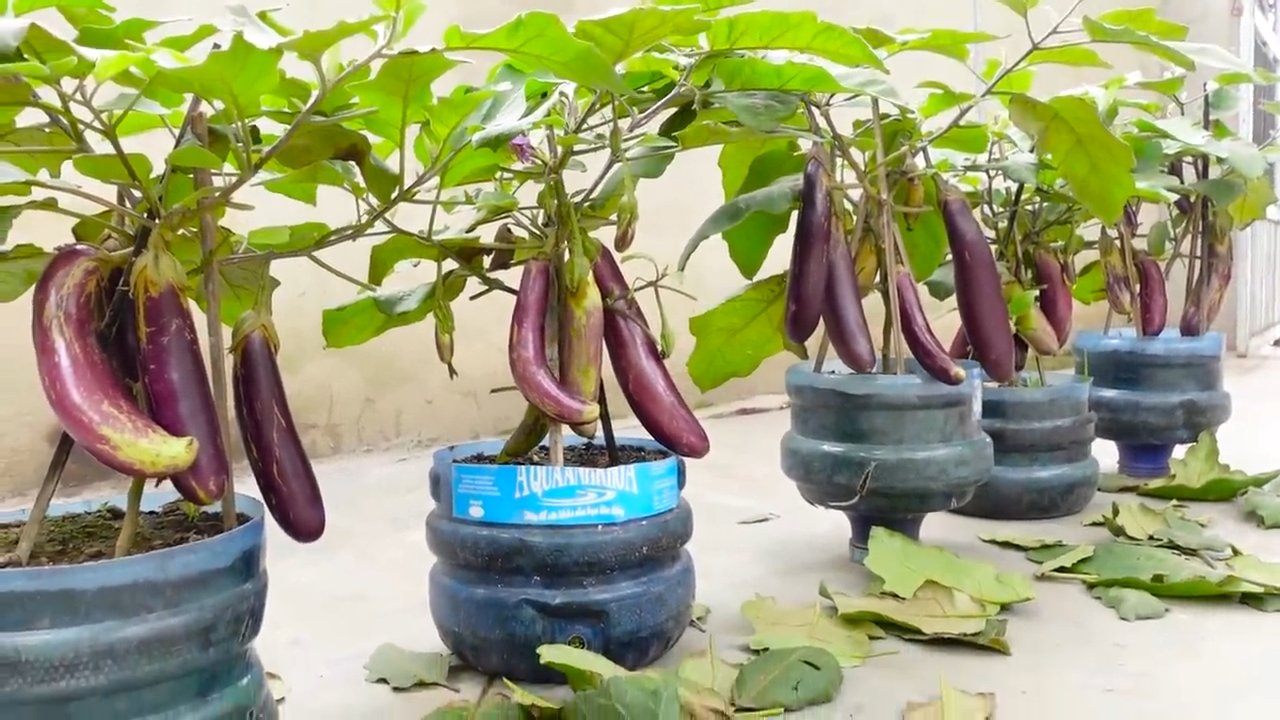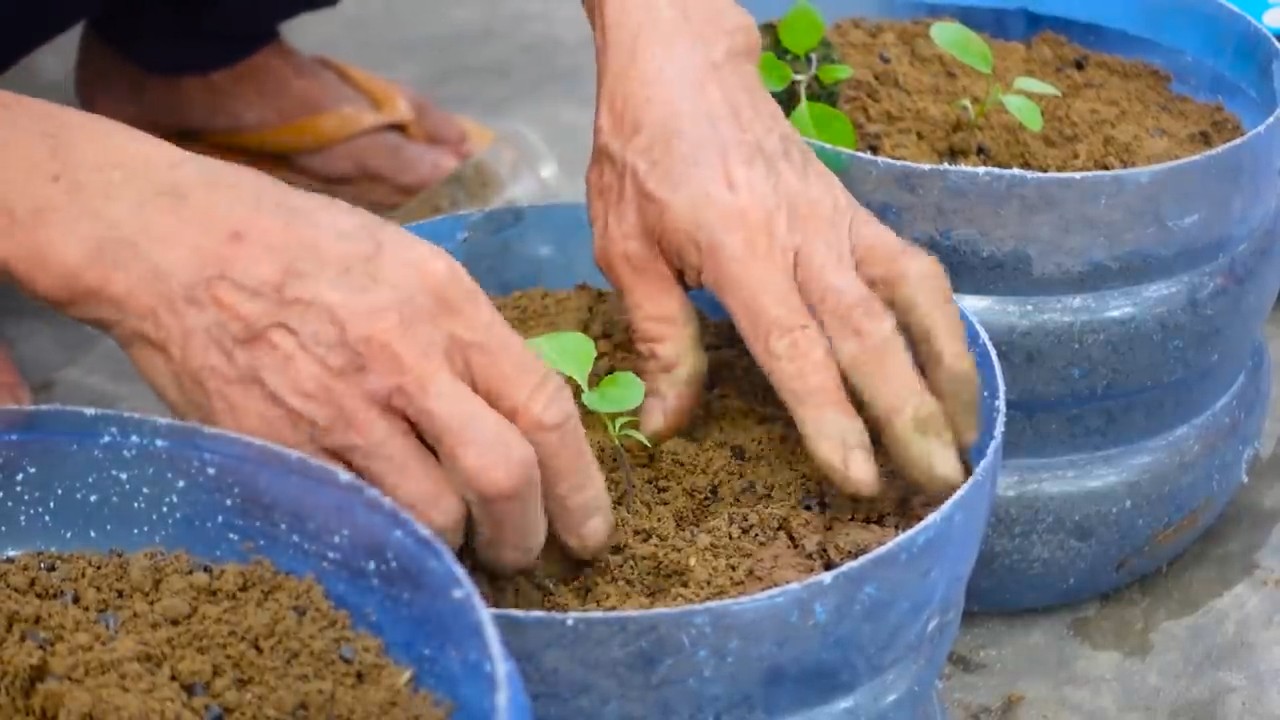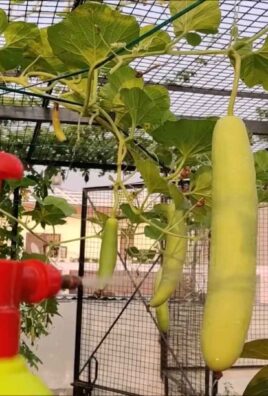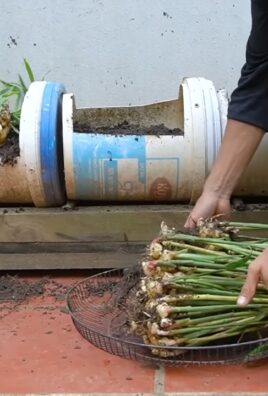Grow eggplant at home, you say? Absolutely! Imagine stepping into your backyard and harvesting plump, glossy eggplants, ready to be transformed into delicious dishes. Forget those bland, overpriced eggplants from the grocery store – with a little know-how, you can cultivate your own vibrant, flavorful crop right in your own backyard.
Eggplant, also known as aubergine, has a rich history, dating back thousands of years to its origins in India. It gradually made its way across the globe, becoming a staple in cuisines from the Mediterranean to Asia. For centuries, it’s been celebrated not only for its unique taste but also for its ornamental beauty, with its striking purple hue adding a touch of elegance to gardens.
But why should you learn to grow eggplant at home? Well, for starters, homegrown produce simply tastes better! Plus, you have complete control over what goes into your plants, ensuring they’re free from harmful pesticides and chemicals. In this article, I’m going to share some simple yet effective DIY tricks and hacks that will help you cultivate a thriving eggplant patch, even if you’re a complete beginner. Get ready to unleash your inner gardener and enjoy the satisfaction of harvesting your very own delicious eggplants!

Growing Eggplants at Home: Your DIY Guide for a Bountiful Harvest
Hey garden friends! Have you ever considered growing your own eggplants? It’s easier than you think, and the result — fresh, flavorful eggplants from your own garden — is simply unbeatable. Let me show you how to do it!
Why Grow Eggplants Yourself?
- Freshness and Flavor: Homegrown eggplants just taste better! They are riper, more flavorful, and have a firmer texture than store-bought ones.
- Control Over Growing Methods: You know exactly what goes into your eggplants. You can avoid pesticides and use organic fertilizers.
- Sustainability: Shorter transport distances help reduce your carbon footprint.
- Satisfaction: There’s something truly rewarding about growing and harvesting your own food!
- Variety: You can grow varieties that aren’t available in stores.
What You Need: Materials List
Before we get started, here’s a list of everything you’ll need to grow eggplants:
- Eggplant seeds or young plants: Choose a variety that suits your climate. There are many different types, from the classic dark purple to striped or white eggplants.
- Seedling pots or trays: For starting your seeds.
- Seed starting soil: Special soil for seedlings, which is nutrient-poor and light.
- Plant pots (optional): If you prefer to grow eggplants in pots.
- Garden soil: Rich, nutrient-dense soil for planting in the garden or in pots.
- Compost or organic fertilizer: To improve soil quality.
- Plant supports or trellises: Eggplants can grow tall and need support.
- Watering can or hose: For watering the plants.
- Pruning shears: For trimming the plants.
- Mulching material (optional): To protect the soil and suppress weeds.
- Greenhouse or polytunnel (optional): For growing in cooler regions.
Starting Eggplants Indoors: Kicking Off the Season
Eggplants need a long growing season, so it’s a good idea to start them indoors. This gives them a head start before they go outside.
Step 1: Sowing the Seeds
- Fill your seedling pots or trays with seed-starting soil.
- Lightly press down the soil and moisten it.
- Place 2-3 seeds per pot, about 0.5 cm deep.
- Cover the seeds with a thin layer of soil.
- Gently spray the soil with water to moisten it.
- Place the pots in a warm, sunny spot (e.g., a windowsill or greenhouse). The ideal germination temperature is 22-25°C.
- Keep the soil moist but not waterlogged.
Step 2: Germination
- Germination typically takes 1-2 weeks.
- Once the first true leaves (besides the seed leaves) appear, move the pots to an even brighter location.
- If multiple seedlings grow in one pot, thin them out by removing the weakest, leaving the strongest plant.
Step 3: Care for Seedlings
- Water the seedlings regularly, but avoid waterlogging.
- After about 2 weeks, feed the plants with a mild liquid fertilizer.
- When the plants reach about 10-15 cm in height, transplant them into larger pots.
Planting Eggplants Outdoors: Time for the Great Outdoors
Once the temperatures rise and there’s no more risk of frost, it’s time to plant your eggplants outdoors.
Step 1: Preparing the Soil
- Choose a sunny location for your eggplants. They need at least 6 hours of sunlight per day.
- Loosen the soil thoroughly and remove any weeds.
- Enrich the soil with compost or organic fertilizer. Eggplants are heavy feeders and require lots of nutrients.
- The soil should be well-drained to avoid waterlogging.
Step 2: Planting the Eggplants
- Dig holes that are slightly larger than the root balls of the eggplant plants.
- Gently place the plants into the holes.
- Fill the holes with soil and lightly press it down.
- Water the plants thoroughly.
- Immediately place plant supports, such as stakes or trellises, next to the plants to support them as they grow.
- Mulch around the plants to retain moisture and suppress weeds.
Step 3: Plant Spacing
- Make sure to space the plants well apart. Eggplants need room to grow.
- A spacing of 45-60 cm between plants and 75-90 cm between rows is ideal.
Care for Eggplants: Tips for a Bountiful Harvest
Proper care is key to getting a great eggplant harvest.
Step 1: Watering
- Eggplants need regular watering, especially during flowering and fruiting.
- Water the plants in the morning so that the leaves can dry out by the afternoon. This helps prevent fungal diseases.
- Avoid waterlogging, as it can cause root rot.
Step 2: Fertilizing
- Fertilize the eggplants regularly with an organic fertilizer or compost.
- Once a week is sufficient.
- Ensure a balanced nutrient supply, especially nitrogen, phosphorus, and potassium, which are essential for eggplants.
Step 3: Pruning
- Prune the eggplant plants regularly to encourage fruiting.
- Remove side shoots that grow below the first flowers.
- Also, remove yellow or diseased leaves.
- Pruning improves ventilation for the plants and reduces the risk of fungal diseases.
Step 4: Pest Control
- Eggplants can be affected by various pests, such as aphids, potato beetles, and spider mites.
- Regularly check the plants for pests.
- If you spot pests, treat the plants with natural pest control methods, such as neem oil or soap-based solutions.
- Beneficial insects, like ladybugs, can help control pests.
Step 5: Disease Prevention
- Eggplants are susceptible to fungal diseases like powdery mildew or gray mold.
- Ensure good ventilation around the plants and avoid waterlogging.
- If diseases occur, use fungicides.
Harvesting Eggplants: The Reward of Your Work
The harvest is the most exciting part of growing eggplants!
Step 1: The Right Time
- Eggplants are ready to harvest when they have a shiny skin and feel firm to the touch.
- The size of the eggplants depends on the variety.
- Gently press on the eggplant. If it gives slightly, it’s ripe.
Step 2: Harvesting
- Cut the eggplant off the plant with pruning shears or a sharp knife.
- Be careful not to damage the plant.
Step 3: Enjoying Your Harvest
- Enjoy your freshly harvested eggplants in a variety of dishes, from grilled eggplant to eggplant Parmesan.
Additional Tips for Growing Eggplants
- Sunshine is Key: Eggplants love the sun. Make sure your planting area gets plenty of sunlight.
- Soil Quality: Eggplants prefer light, well-drained soil. If your soil is heavy or clayey, amend it with compost and sand.
- Pest and Disease Prevention: Regularly check your plants for pests and signs of disease. Early detection helps prevent serious damage.
- Rotate Planting Areas: Avoid planting eggplants in the same spot every year to prevent soil depletion and disease buildup.
Conclusion
Growing eggplants at home can be very rewarding, and with the right care, you’ll be able to enjoy fresh, homegrown eggplants all season long. With patience, love, and the right techniques, anyone can grow these delicious vegetables. Happy gardening!

Conclusion
So, there you have it! Growing your own eggplant at home is not only achievable, but it’s also incredibly rewarding. From selecting the perfect variety to nurturing your seedlings and harvesting those glossy, vibrant fruits, every step of the process connects you to the earth and provides a deep sense of satisfaction. This DIY approach allows you to bypass the often-questionable practices of large-scale agriculture and enjoy eggplant that is truly fresh, flavorful, and free from unwanted chemicals.
But why is this DIY trick a must-try? Beyond the obvious benefits of fresh produce, growing eggplant at home empowers you to control the entire growing process. You choose the soil, the fertilizers (or lack thereof!), and the pest control methods. This level of control translates to healthier plants and, ultimately, healthier food for you and your family. Plus, let’s be honest, there’s a certain bragging right that comes with serving a dish featuring eggplant you cultivated yourself!
Consider these variations to personalize your eggplant-growing journey:
* **Container Gardening:** If you’re short on space, don’t despair! Eggplant thrives in containers, making it perfect for balconies, patios, or even sunny windowsills. Choose a large container (at least 5 gallons) and ensure it has excellent drainage.
* **Grafting:** For increased disease resistance and vigor, explore grafting your eggplant onto a more robust rootstock. This technique, while a bit more advanced, can significantly improve your chances of success, especially in challenging climates.
* **Companion Planting:** Maximize your garden’s potential by planting companion plants alongside your eggplant. Basil, marigolds, and thyme are excellent choices, as they deter pests and attract beneficial insects.
* **Different Varieties:** Don’t limit yourself to the standard globe eggplant! Experiment with different varieties like Japanese eggplant (long and slender), Thai eggplant (small and round), or even white eggplant for a unique culinary experience.
Growing eggplant at home is more than just a gardening project; it’s an investment in your health, your well-being, and your connection to nature. It’s a chance to learn new skills, to appreciate the miracle of growth, and to enjoy the unparalleled flavor of homegrown produce.
We wholeheartedly encourage you to give this DIY trick a try. Start small, be patient, and don’t be afraid to experiment. The rewards are well worth the effort. And most importantly, we want to hear about your experiences! Share your photos, tips, and challenges in the comments below. Let’s build a community of eggplant enthusiasts and learn from each other’s successes (and failures!). Happy gardening!
Frequently Asked Questions (FAQ)
What is the best time to start growing eggplant from seed?
The ideal time to start eggplant seeds indoors is typically 8-10 weeks before the last expected frost in your area. Eggplant requires warm temperatures to germinate and thrive, so starting them indoors gives them a head start. Check your local frost dates to determine the appropriate timing for your region. If you live in a warmer climate with a long growing season, you can start seeds directly in the ground after the danger of frost has passed, but indoor starting is generally recommended for most regions.
How much sunlight does eggplant need?
Eggplant requires at least 6-8 hours of direct sunlight per day to produce a good yield. Choose a sunny location in your garden or on your patio where your eggplant plants will receive ample sunlight throughout the day. If you’re growing eggplant indoors, supplement with grow lights if necessary to ensure they get enough light. Insufficient sunlight can lead to leggy plants, poor fruit production, and increased susceptibility to pests and diseases.
What kind of soil is best for growing eggplant?
Eggplant prefers well-drained, fertile soil that is rich in organic matter. The ideal soil pH is between 6.0 and 7.0. Before planting, amend your soil with compost, aged manure, or other organic materials to improve its fertility and drainage. Avoid heavy clay soils, as they can become waterlogged and inhibit root growth. If you’re growing eggplant in containers, use a high-quality potting mix that is specifically formulated for vegetables.
How often should I water my eggplant plants?
Eggplant needs consistent moisture to thrive, especially during hot weather. Water deeply and regularly, aiming to keep the soil consistently moist but not waterlogged. Check the soil moisture regularly and water when the top inch feels dry to the touch. Avoid overhead watering, as this can increase the risk of fungal diseases. Instead, water at the base of the plants, using a soaker hose or drip irrigation system if possible. Mulching around the plants can also help to retain moisture and suppress weeds.
What are some common pests and diseases that affect eggplant?
Eggplant is susceptible to a variety of pests and diseases, including aphids, flea beetles, spider mites, tomato hornworms, and verticillium wilt. Regularly inspect your plants for signs of infestation or disease. Use organic pest control methods, such as insecticidal soap, neem oil, or handpicking, to control pests. To prevent diseases, ensure good air circulation around your plants, avoid overhead watering, and practice crop rotation. Choose disease-resistant varieties whenever possible.
How do I know when my eggplant is ready to harvest?
Eggplant is typically ready to harvest when the fruit is glossy, firm, and has reached its mature size and color. The skin should be smooth and unblemished. Gently press the skin with your thumb; if it leaves a slight indentation, the eggplant is ripe. Use a sharp knife or pruning shears to cut the eggplant from the plant, leaving a short stem attached. Overripe eggplant will become dull in color, soft, and bitter in taste.
Can I grow eggplant in containers?
Yes, eggplant can be successfully grown in containers, making it a great option for gardeners with limited space. Choose a large container (at least 5 gallons) with good drainage holes. Use a high-quality potting mix and provide your eggplant plants with plenty of sunlight and water. Container-grown eggplant may require more frequent watering and fertilization than those grown in the ground.
How do I fertilize my eggplant plants?
Eggplant is a heavy feeder and benefits from regular fertilization. Use a balanced fertilizer (e.g., 10-10-10) at planting time and then side-dress with compost or a nitrogen-rich fertilizer every few weeks during the growing season. Avoid over-fertilizing, as this can lead to excessive foliage growth and reduced fruit production. Follow the instructions on your fertilizer label carefully.
Why are my eggplant flowers falling off without producing fruit?
This is a common problem known as blossom drop. It can be caused by a variety of factors, including high temperatures, low humidity, poor pollination, and nutrient deficiencies. To prevent blossom drop, ensure your eggplant plants are getting enough sunlight, water, and nutrients. Hand-pollinate the flowers if necessary, especially during hot weather. Provide shade during the hottest part of the day.
How can I improve pollination for my eggplant plants?
Eggplant flowers are self-pollinating, but they can benefit from a little help, especially in hot or humid weather. You can hand-pollinate the flowers by gently shaking the plants or using a small paintbrush to transfer pollen from one flower to another. Attracting pollinators to your garden, such as bees and butterflies, can also improve pollination. Plant flowers that attract pollinators near your eggplant plants.





Leave a Comment